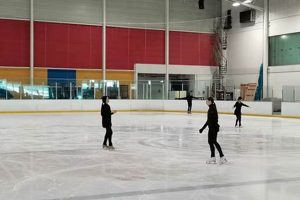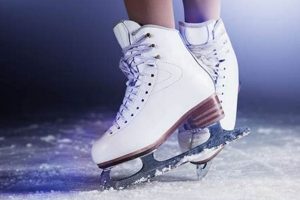This recreational equipment facilitates movement across ice surfaces. Characterized by a specialized boot attached to a blade, it allows individuals to glide and maneuver on frozen bodies of water or prepared ice rinks. A common application is in leisure activities such as recreational skating and ice hockey.
The equipment offers opportunities for physical exercise, improving balance and coordination. Historically, ice skating provided a means of transportation across frozen waterways. Its evolution has led to its modern use in sports and recreational pursuits, contributing to both physical fitness and enjoyment. The equipment has undergone continuous development, incorporating advancements in materials and design to enhance performance and comfort.
The following sections will delve deeper into specific aspects related to equipment selection, maintenance, and the various activities and sports in which it is commonly employed.
Essential Considerations for Ice Skating Equipment
Selecting and maintaining appropriate skating equipment is crucial for safety and performance on the ice. The following guidelines offer practical advice for users of all skill levels.
Tip 1: Proper Sizing is Paramount: Ensure the skate boot fits snugly, providing adequate ankle support without restricting circulation. Ill-fitting skates can lead to discomfort and compromise stability.
Tip 2: Blade Sharpness Affects Performance: Regularly check the blade’s edge. A dull blade reduces grip and control, increasing the risk of falls. Sharpening should be performed by a qualified professional.
Tip 3: Ankle Support is Critical: The boot must offer sufficient lateral support to prevent ankle strain. Consider the boot’s stiffness, especially for beginners who require more support.
Tip 4: Lacing Technique Influences Stability: Lace the skates firmly, paying particular attention to the ankle area. Tighten the laces securely, but avoid over-tightening, which can restrict blood flow.
Tip 5: Regular Maintenance Extends Lifespan: After each use, wipe the blades dry to prevent rust. Store skates in a well-ventilated area to prevent moisture buildup.
Tip 6: Blade Guards Protect Against Damage: Use blade guards when walking off the ice. This prevents nicks and scratches that can degrade performance.
Tip 7: Consider Protective Gear: Helmets, knee pads, and elbow pads are recommended, especially for beginners or those attempting advanced maneuvers. Safety should always be a priority.
Adhering to these recommendations contributes to a safer and more enjoyable experience on the ice. Proper selection, maintenance, and usage of equipment are fundamental aspects of ice skating.
The concluding sections will provide information on advanced techniques and the benefits of professional instruction.
1. Blade Material
The performance characteristics of ice skating equipment are directly influenced by the composition of the blade. The selection of blade material significantly impacts edge retention, glide efficiency, and overall durability. For example, carbon steel alloys are frequently utilized due to their ability to maintain a sharp edge, crucial for controlled movement and maneuverability on the ice. The quality of steel directly affects the skater’s ability to execute precise turns and stops, influencing both recreational enjoyment and competitive performance. Inadequate blade material can lead to premature dulling, requiring more frequent sharpening and potentially affecting safety due to reduced control.
Consider the contrast between entry-level recreational skates and high-performance models. Entry-level skates often utilize softer steel compositions, which may be more forgiving for beginners but require more frequent sharpening. Conversely, advanced models employ harder, higher-grade steel alloys designed to withstand the rigorous demands of competitive skating, where edge control is paramount. Furthermore, some blades are coated with specialized materials to reduce friction and enhance glide, exemplifying the ongoing advancements in blade technology and its direct effect on skating performance. This illustrates how choice of blade material affects maintenance requirements and skating quality.
In summary, blade material represents a critical component in equipment performance and user safety. Understanding the properties and implications of different blade materials is essential for making informed purchasing decisions and ensuring a satisfying and safe experience on the ice. The selection of an appropriate blade material must align with the skater’s skill level and intended use, highlighting the fundamental relationship between material science and athletic performance.
2. Boot Stiffness
Boot stiffness is a fundamental characteristic influencing the performance and suitability of ice skating equipment. The degree of rigidity in the boot directly affects energy transfer, ankle support, and overall control on the ice. Consequently, the selection of appropriately stiff boots is critical for optimizing performance and minimizing the risk of injury.
- Energy Transfer Efficiency
Stiffer boots provide more efficient energy transfer from the skater’s leg muscles to the blade. This improved energy transfer allows for quicker acceleration, sharper turns, and more powerful jumps. Conversely, more flexible boots absorb more energy, resulting in reduced performance. The level of stiffness directly corresponds to the skater’s ability to execute technically demanding maneuvers.
- Ankle Stability and Support
High levels of ankle support are crucial for preventing injuries, particularly ankle sprains and strains. Stiffer boots offer greater lateral stability, minimizing the risk of ankle roll during turns and landings. This increased stability is particularly important for beginner skaters who may lack the muscle strength and coordination to properly stabilize their ankles independently. Its also useful for preventing injuries
- Responsiveness and Control
The responsiveness of the equipment is directly related to boot stiffness. Stiffer boots provide a more direct and immediate response to the skater’s movements, allowing for precise control over blade angle and direction. This heightened responsiveness is essential for advanced skating techniques and competitive performance, where subtle adjustments can significantly impact execution.
- Skill Level and Intended Use
The appropriate level of boot stiffness is determined by the skater’s skill level and intended use. Beginners typically benefit from more flexible boots that offer greater comfort and allow for a more natural range of motion. Advanced skaters, however, require stiffer boots that provide the necessary support and responsiveness for executing complex maneuvers. The boot stiffness should align with the specific demands of the skating discipline, whether it be recreational skating, hockey, or figure skating.
The multifaceted role of boot stiffness underscores its importance in ice skating equipment selection. Understanding the interplay between stiffness, energy transfer, ankle support, responsiveness, and skill level is essential for optimizing performance and ensuring safety on the ice. The selection of appropriately stiff boots directly contributes to a more enjoyable and effective skating experience.
3. Ankle Support
Ankle support, as a design characteristic of the mentioned ice skate, is critical for stability and injury prevention. The structure of the boot, its height above the ankle joint, and the materials employed directly influence the degree of support offered. Insufficient support increases the risk of sprains, strains, and other lower limb injuries, particularly when performing complex maneuvers or skating at high speeds. Conversely, adequate ankle support enhances control, allowing for more precise movements and improved balance. Ankle support design in the discussed equipment involves a complex balancing act between support and flexibility.
The degree of ankle support required varies depending on the skater’s skill level and the intended use of the equipment. Beginner skaters often benefit from higher, stiffer boots providing maximum support. More experienced skaters may prefer a lower cut boot with greater flexibility, enabling more intricate footwork. This is particularly evident in figure skating, where freedom of movement is essential for executing jumps and spins. Hockey skates represent a middle ground, balancing support and maneuverability for the demands of the sport. The effectiveness of ankle support is observable in the reduced incidence of ankle injuries among skaters using properly fitted and supportive equipment.
In summary, ankle support represents a crucial safety and performance feature, directly affecting stability, control, and injury prevention. The design of these ice skates requires careful consideration of the skater’s skill level, intended use, and biomechanical needs. Understanding the connection between ankle support and skating performance enables informed equipment selection and promotes a safer, more enjoyable skating experience. Manufacturers continually refine design to strike an optimum balance between support and flexibility.
4. Closure System
The closure system represents a critical interface between the skater and the ice skating equipment. It dictates how securely and precisely the skate is fastened to the foot, influencing comfort, performance, and safety. Diverse mechanisms serve this function, each offering distinct advantages and disadvantages.
- Lacing Systems: Precision and Customization
Traditional lacing systems remain prevalent in various ice skate models. Laces enable precise tightening across the foot and ankle, allowing for customized fit and support. Different lacing patterns can emphasize support in specific areas, such as the ankle or instep. However, lacing systems require manual adjustment and may loosen during use, demanding periodic retightening to maintain optimal fit and performance.
- Buckle Systems: Convenience and Security
Buckle systems provide a quick and secure method of fastening the skate. Typically incorporating ratcheting mechanisms, buckles offer ease of adjustment and consistent tightness. Buckle systems are commonly found in recreational and hockey skates, where convenience and reliable closure are prioritized. While buckles offer speed and security, they may lack the fine-tuning capabilities of lacing systems.
- Velcro Straps: Simplicity and Ease of Use
Velcro straps provide a simple and intuitive closure mechanism, particularly suitable for beginners and young skaters. These straps offer ease of adjustment and can be quickly fastened and unfastened. However, Velcro straps may not provide the same level of support and security as lacing or buckle systems, and their effectiveness can diminish over time with wear and tear.
- Hybrid Systems: Combining Best Features
Some equipment incorporate hybrid closure systems, combining elements of lacing, buckles, and straps. These hybrid systems aim to leverage the advantages of each mechanism, offering a blend of precision, convenience, and security. For instance, a skate may feature a lacing system in the lower portion of the boot for customized fit and a buckle system in the ankle area for enhanced support.
The selection of an appropriate closure system depends on individual preferences, skating style, and performance requirements. Factors such as ease of use, level of support, and adjustability should be considered when evaluating different closure systems. The closure system plays a pivotal role in ensuring a secure, comfortable, and efficient connection between the skater and the ice, impacting both performance and overall skating experience.
5. Blade Radius
Blade radius, a critical specification of an ice skate, denotes the curvature of the blade along its length. This curvature profoundly influences the skate’s maneuverability, edge control, and gliding efficiency. Specifically, a smaller radius (deeper curve) enhances agility, enabling tighter turns and quicker stops. Conversely, a larger radius (flatter blade) promotes stability and speed in straight lines. The selection of an appropriate radius depends on the intended use, skating style, and skill level of the user. In the context of general-purpose ice skates, such as those intended for recreational use, the blade radius typically represents a compromise between agility and stability, catering to a wide range of skating activities. The consequences of an inappropriate radius include compromised control, increased fatigue, and potentially elevated risk of injury.
Consider the contrasting examples of hockey skates and figure skates. Hockey skates commonly feature a smaller blade radius, prioritizing agility and rapid changes in direction necessary for game play. Figure skates, on the other hand, exhibit a more pronounced blade radius, allowing for intricate footwork and edge control required for jumps and spins. Recreational ice skates generally incorporate an intermediate radius, suitable for both leisurely gliding and basic maneuvers. The relationship between blade radius and performance is further exemplified in the sharpening process. Skilled technicians can adjust the blade radius to fine-tune the skate’s characteristics, optimizing it for specific skating demands. This demonstrates the ability to alter the blades behavior and adjust the skating feel.
In conclusion, blade radius is an integral design parameter directly influencing a skates performance characteristics. Understanding the interplay between blade radius, skating style, and intended use enables informed equipment selection, resulting in enhanced control, efficiency, and safety on the ice. The specific radius selected greatly affects the way the user can perform. Manufacturers strive to optimize blade radius configurations to meet the diverse needs of skaters, ensuring a blend of maneuverability and stability.
6. Intended Use
The connection between “Intended Use” and ice skating equipment is fundamental, determining the suitability and performance of a given skate model. The design and construction of a specific model are directly influenced by the activities for which it is intended. Selecting the proper skate, therefore, requires a careful consideration of the skater’s needs and planned usage. The consequences of mismatching equipment with intended use can range from diminished performance to increased risk of injury.
Recreational skates, for instance, prioritize comfort and ease of use, featuring softer boots and moderate blade profiles suitable for casual gliding and beginner-level maneuvers. Conversely, hockey skates are engineered for high-impact performance, characterized by rigid boots, reinforced ankle support, and aggressive blade designs optimized for rapid acceleration and precise turns. Figure skates represent a specialized category, emphasizing blade curvature and boot flexibility to facilitate intricate footwork and aerial maneuvers. The selection of a skate designed for a different purpose can lead to inefficiencies in technique and elevated risk of injury. A hockey player in figure skates would experience compromised agility and control, while a recreational skater in hockey skates might find the stiffness uncomfortable and limiting.
Understanding the intended use is crucial for optimizing skating performance and safety. The market offers a wide array of skate models, each tailored to specific activities and skill levels. Selecting the appropriate skate requires a thorough assessment of personal needs and planned usage. The repercussions of choosing the wrong model include both diminished performance and heightened injury risk. The integration of design elements, from boot stiffness to blade curvature, directly relates to the intended purpose of the equipment, making this parameter a critical factor in the selection process.
Frequently Asked Questions
The following questions address common inquiries regarding ice skating equipment, focusing on considerations relevant to selection, maintenance, and safe usage.
Question 1: How often should ice skate blades be sharpened?
The frequency of blade sharpening depends on usage intensity and ice conditions. Blades should be sharpened when a loss of edge control is noticeable. Professional skaters often sharpen blades after each session, while recreational users may only require sharpening once or twice per season.
Question 2: What constitutes a proper fit for ice skating boots?
Ice skating boots should fit snugly, providing adequate ankle support without restricting circulation. The toes should lightly touch the end of the boot when standing, with minimal heel lift during forward movement. Ill-fitting boots can compromise stability and increase the risk of blisters.
Question 3: How should ice skate blades be stored to prevent rust?
After each use, blades should be thoroughly dried with a clean cloth. Blade guards should be used when walking off the ice to protect the edges. For long-term storage, blades can be coated with a thin layer of oil to prevent rust formation.
Question 4: What is the significance of ankle support in ice skating boots?
Ankle support is critical for stability and injury prevention. The boot should provide sufficient lateral support to prevent ankle roll during turns and landings. Insufficient ankle support can lead to sprains and other lower limb injuries.
Question 5: What protective gear is recommended for ice skating?
Helmets are strongly recommended, especially for beginners. Knee pads and elbow pads can provide additional protection during falls. Wrist guards can also help prevent injuries to the wrists.
Question 6: How does blade radius affect ice skating performance?
Blade radius, the curvature of the blade, influences maneuverability. A smaller radius allows for tighter turns, while a larger radius promotes stability and speed in straight lines. The selection of blade radius should align with the skater’s skill level and intended use.
Adhering to these guidelines contributes to a safer and more enjoyable skating experience. Proper selection and maintenance of equipment are essential for both performance and safety.
The subsequent section will address advanced techniques.
Concluding Remarks on Brentwood Ice Skate
This article has presented a comprehensive overview of ice skating equipment, specifically focusing on elements crucial to its function and safety. Key considerations, including blade material, boot stiffness, ankle support, closure systems, blade radius, and intended use, directly impact the user’s experience. A thorough understanding of these parameters facilitates informed decision-making in equipment selection and promotes safe skating practices.
The information provided serves as a foundation for skaters of all skill levels. Prioritizing proper equipment and maintenance enhances performance and mitigates potential risks. Further research into specialized techniques and equipment advancements is encouraged for continued improvement and safety awareness within the sport.







